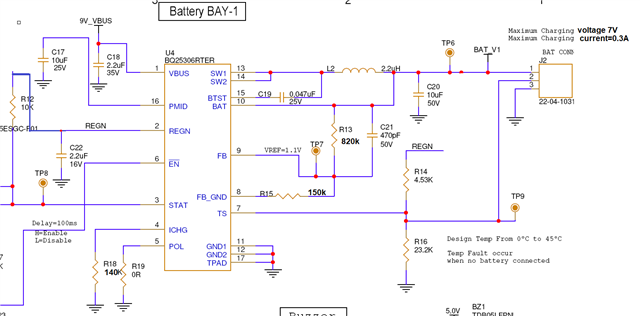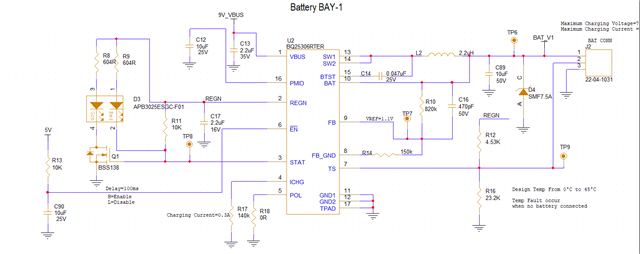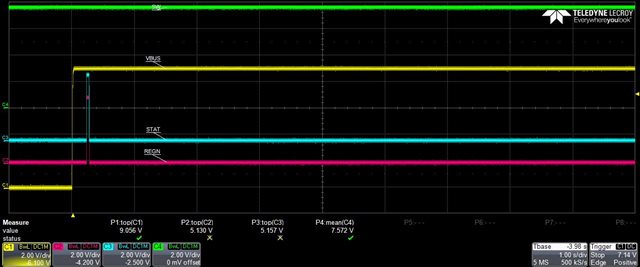Tool/software:
Hello,
I have designed a custom Li-ion battery charger circuit using the BQ25306.
Charging Voltage=7.1V
Charging Current=0.3A

Regards
Sabitha N
This thread has been locked.
If you have a related question, please click the "Ask a related question" button in the top right corner. The newly created question will be automatically linked to this question.
Tool/software:
Hello,
I have designed a custom Li-ion battery charger circuit using the BQ25306.
Charging Voltage=7.1V
Charging Current=0.3A

Regards
Sabitha N
Hi Sabitha,
I can confirm the behavior you observe is not expected for the test condition you describe. When I test a battery overvoltage condition on the BQ25306 EVM I observe REGN remain on at approx. 5V. Given this can you please help to answer a couple follow-up questions.
1)Some components connected to REGN appear to be cutoff in the provided schematic. Can you please help to share a version of the schematic which shows all components connected to REGN.
2) Can you please help to share a waveform capture showing VBUS, REGN, and VBAT when you observe REGN voltage go low? REGN will turn off if VBUS is not a sufficiently higher voltage than VBAT. Have you checked if your input voltage is possibly at a lower than expected voltage for this test case?
Best Regards,
Garrett
Hello Garrett Kreger ,
1.Please see below the full schematic of the battery charger.

Regards
Sabitha
Hi Sabitha,
Thank you for the response and update on components which are populated on the board during your testing.
In my testing with the BQ25306EVM up to this point I did not modify on board components so the full charge voltage is set to 8.4V. I had a 9V input supply connected at VBUS and then increase VBAT until REGN turns off.
When 9V input supply is connected and then battery voltage is increased I do not observe REGN turn off until VBAT is approx. 8.95V. If overvoltage at VBAT is present first then 9V input is connected I see REGN not turn on when VBAT is 8.85V or higher. The threshold is different based on if REGN is starting up or already on. In either case VBAT is > 400mV above full charge voltage and REGN remains on.
In my testing REGN only turns off when VBUS is not > VBAT + VSleepz.
Additionally, generally speaking please be aware REGN is not designed to be able to support greater than 20mA in external current draw, but given components not assembled on your board this should not be an issue with only TS resistor network and 10kohm resistor from STAT connected to REGN.
Best Regards,
Garrett
Hi Garrett,
My goal is to charge a battery up to 7.1V, and Once the battery reach 7.1V and Charger IC should indicate charging complete and I'm wondering if the BQ25306 IC can supports charging up to this voltage level.
Could you please advise on whether this configuration is possible and why I might be experiencing the short circuit on the REGN pin?
Could it be possible to modify your Evm board as below and do the over voltage (7.5V) test?
1.charging Voltage:7.1V
2.Charging Current:0.3A
Please let me know if this modification and measurement are feasible.
Hi Sabitha,
Yes BQ25306 can support charging up to 7.1V and using the equation listed in the Pin Functions table of the datasheet for 'FB' pin your resistor selection shown in your schematic is correct for setting VBATREG = 7.1V.
This difference in VBATREG setting is not expected to have any impact of REGN functionality. I have verified on EVM that REGN pin remains on for a bat OVP condition independent of the VBATREG (full charge voltage) setting.
Therefore to continue debug please help to capture a waveform capture showing VBUS, REGN, and VBAT when you observe REGN voltage go low?
Best Regards,
Garrett
Hi Garrett,
For Over Voltage condition, i have tried with new board and captured the waveform and observed REGN is shorted to gnd.

Charging Voltage -7.1V
Green--VBAT (7.5V)
Yellow-VBUS (9V)
Pink-REGN
blue-STAT
Regards
Sabitha N
Hi Sabitha,
Thank you for your response.
Regarding my test case, I wanted to let you know that resistors R8 and R9, diodes D3 and D4, and transistor Q1 were not assembled to the REGN pin. Additionally, diode D4 was not mounted. The STAT pin is connected to the REGN pin via a pull-up resistor R11.
On this new board is the above statement regarding populated components previously provided still true or is the board populated according to your schematic?
Best Regards,
Garrett
Hi Garrett,
R8 and R9, diodes D3 and D4, and transistor Q1 were not assembled to the REGN pin. Additionally, diode D4 was not mounted.
Regards,
Sabitha
Hi Sabitha,
Apologies for the delay. I somehow missed your latest response.
Firstly, just to clarify when you say you tested with a new board does that mean the new board also had a new IC? Or was the same IC swapped onto the new board?
Secondly, a couple additional suggestions for continuing debug. Do you by chance change logic level of /EN pin when battery is in OVP condition? Have you checked EN pin voltage in your testing where REGN crashes after input is connected? It may also be worth checking if REGN behavior changes in this test if you remove R18 to leave POL pin floating and also leave EN floating (or pulled to GND).
Best Regards,
Garrett